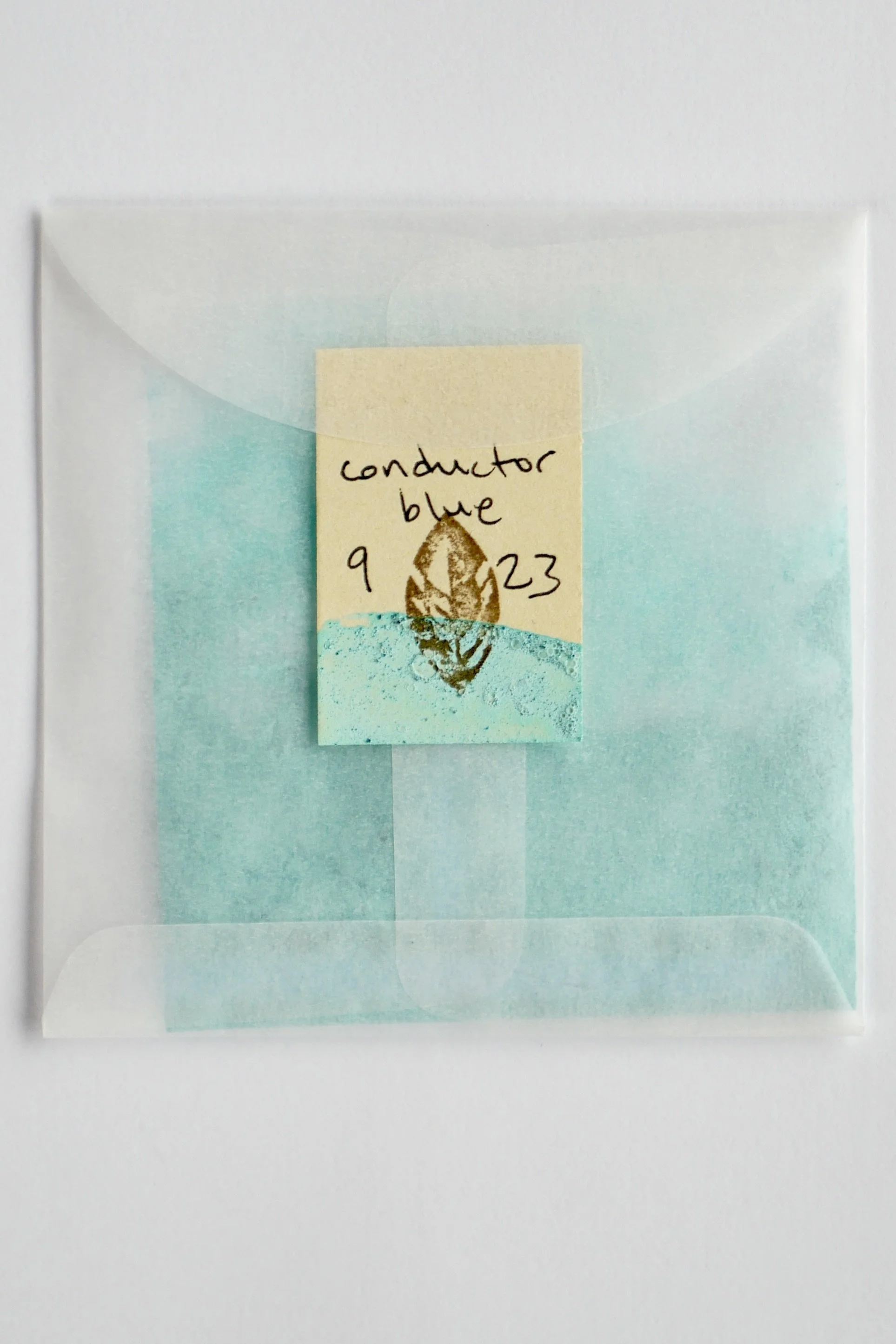conductor blue : september ’23
This month’s pigment is the result of a group contribution: three different artists who made turquoise blue, copper-based pigments in three different locations.
‘Conductor Blue’ was named by pigment contributor Lucy Mayes, of London Pigment. Copper is the most conductive metal, it’s true: in this case, the copper in Conductor Blue serves to connect people and visions instead of electricity, though much of the Conductor Blue copper may have done just that in its former life. All the copper in this pigment was gleaned from the trash (wire, old pipes, etc.), and soaked in or suspended over some sort of acid, like vinegar (or milk!). When acid combines with oxygen on copper surfaces, the greenish blue COPPER ACETATE forms, especially when salt is also present. The State of Liberty’s green hue is the result of atmospheric mingling between Manhattan and the salty harbor air. You can also sometimes see copper acetate on US pennies made before September 1982.
Conductor Blue is a technically a gouache pigment, made by blending the copper acetate powdered pigment from three artists — Lucy Mayes, Catalina Christensen, & Jason Logan — with powdered chalk from a health food store (often used in cosmetics). Copper acetate — also known as ‘verdigris’ — is quite time-consuming to make. It’s also poisonous when eaten, and unhealthy if breathed in in quantities over time (& an irritant if breathed in at all).
contributor: Catalina Christensen
Catalina Christensen uses natural rock pigments collected in Colombia and processed in her studio, as well as indigo dye and metal powders to create new pigments. Her singular style is the ever-evolving product of her experimental nature. For Catalina, the collection and preparation of the pigments is an artistic endeavour in itself, and therefore she includes them in her exhibitions. Catalina co-founded The Wilderness Art Collective, a group of creatives, artists, explores and environmentalists whose work discuses the natural world and is a fellow of the Royal Geographical Society (with IBG). www.catalinachristensen.com
contributor: Lucy Mayes
LUCY MAYES is an artist and pigment maker working in London. Her work with pigments is manifest in three core activities; making pigments under the name ‘London Pigment’ for purchase, painting and giving workshops. This work uses urban waste stream materials to make recycled pigment as a way of narrating a modern lived experience. She previously studied at The Ruskin, Oxford University and The Royal College of Art where her interest in colour theory, pigment processing and paint making began. www.londonpigment.com
contributor: Jason Logan
JASON LOGAN is an illustrator, writer, graphic designer, and art director based in Toronto, Ontario, Canada. He’s the founding director of the Toronto Ink Company and author of Make Ink. His first book, If We Ever Break Up, This Is My Book, has been translated into seven languages. Logan has also created hand-lettering and designed book covers for Coach House Books and Harper Collins. He is currently working on a book about ink-making for kids. www.torontoinkcompany.com
Image from Apache Stronghold website.
22% donation recipient: apache stronghold
Apache Stronghold, San Carlos, Arizona, is a 501(c)3 nonprofit community organization of individuals who come together in unity to battle continued colonization, defend Holy sites and freedom of religion, and are dedicated to building a better community through neighborhood programs and civic engagement. We work from San Carlos, Arizona connecting Apaches and other Native and non-Native allies from all over the world. Chi’chil Biłdagoteel (also known as Oak Flat) is a sacred site for our Apache people and many other Native Americans. This is a place that has special significance— a place where we pray, collect water and medicinal plants for ceremonies, gather acorns and other foods, and honor those that are buried here. We have never lost our relationship to Chi’chil Biłdagoteel, though the U.S. Government, at times in our history, has imprisoned us on our Reservations and not allowed us to come here. We have established an encampment to protect the Holy Ground at Chi’chil Biłdagoteel with its four crosses, representing the entire surrounding sacred area, including its water, animals, oak trees, and other plants central to our tribal identity. The four crosses are now part of the body of Chi’chil Biłdagoteel.






